Old people require little sleep and, no, I don’t know why. It is not like you get to an age and you decide life is so precious you don’t want to waste a second of it sleeping. And it is not like you become afraid that you will go to sleep and you will go to… you know… SLEEP. No matter what time I go to bed; midnight, 1 AM, I will pop up like a piece of overdone toast at 6:00 AM, only to find that my wife has already been up for an hour, finishing painting the house or changing the oil in the car. So I wander into work, talk Alexa into playing Leon Russell’s rendition of Delta Lady, a little musical slap in the face, and I’m ready to go… with just a little bit more coffee.
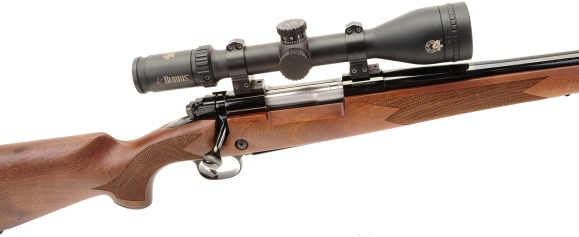
When we last communicated… that would have been at the conclusion of Part I, I was rambling on about working up some heavy bullet handloads for the Winchester Model 70 and the 30-06 Springfield, but I don’t believe I mentioned why?
As outlined in Part I, The Winchester Model 70 Super Grade is a well made and accurate classic firearm. While the Winchester has many positive attributes that qualify it as a terrific hunting rifle, its 24″ barrel, compared to most 30-06 Springfield rifles with 22″ barrels, provides a boost in velocity and its standard sporter weight helps dampen recoil.
The 30-06 Springfield is enough cartridge to convincingly drop any game in the Americas, but I don’t want to make that a personal assertion as it would be no more valid than any stranger advancing that notion. So I will go with Alaska’s Department of Fish and Game, citing their opinion and the opinion of Alaskan Guides that more animals are wounded and people injured when they insist on carrying heavy magnums they can’t properly shoot. The preference is that hunters bring a rifle chambered for a cartridge they can shoot well, loaded with carefully selected bullets. The relevant passage from the Alaska Department of Fish and Game is –
“If you are going to hunt brown bear on the Alaska Peninsula or Kodiak Island, a .30-06 loaded with 200- or 220-grain Nosler® or similar premium bullet will do the job with good shot placement. Only consider using a .300, .338 or larger magnum if you can shoot it as well as you can the .30-06″.
Which all carries us to the point of Part II, “Heavy Hornady hitting with the 30-06 Springfield”.
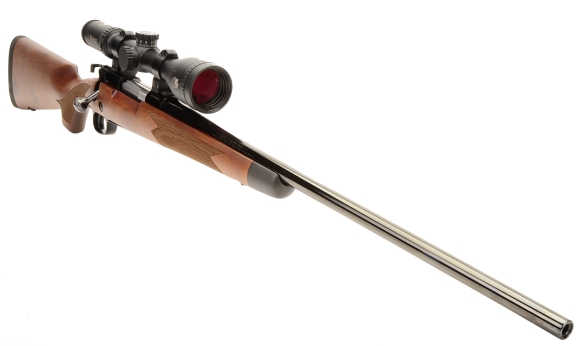
Hornady’s 30 caliber heavyweight line up…
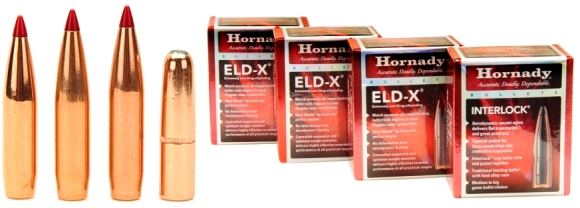
Four Hornady bullets were selected for the heavy handload section. The Hornady ELD-X bullets were selected for handloads for use with medium to large game, the Hornady round nose Interlock was selected for big, dangerous game applications. The application recommendation is from the manufacturer, a source with generations of design experience and enhanced test methods, and with a great deal of empirical data to guide product development and application validation.
Hornady, rightfully proud of their achievement, was nice enough to package tons of insightful information as white papers, product support documents and professionally produced video. Good thing, as I can honestly say I have never purchased a bullet or firearm based on an article with a picture of a person I don’t know, kneeling along side of a dead animal, espousing the virtues of a bullet based on that event. Nor have I ever purchased a bullet based on anonymous social media testimony where the poster indicates they only use a bullet with a 0.351 sectional density and never an 0.352… but that’s just me.
The Hornady ELD-X
There are numerous reasons why the Hornady ELD-X and Hornady Interlock bullets were specifically matched up with the 30-06 Springfield. Marking up one of Hornady’s cutaway drawings from their product image library…
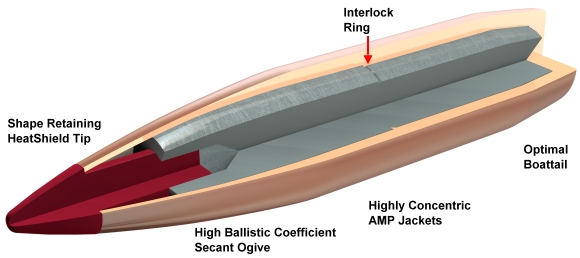
The HeatShield® tip is made from a Hornady proprietary high temp poly that, unlike competing products, will not melt of deform during extended time in flight; 500 yards and beyond. However, close in or far out, high or diminished velocity, the HeatShield is drives back into the bullet and triggers controlled expansion on impact.
The secant ogive offers a more gradual bullet tip taper in comparison to a tangent ogive, spire tip, design. Combined with an optimized boattail form, the result is a high ballistic coefficient. AMP jackets, the product of Hornady’s Advanced Manufacturing Process, are highly uniform in material thickness and concentricity, which keep the bullet rotating tightly about its longitudinal axis.
The Hornady Interlock ring holds the jacket securely to the bullet’s core, even with maximum bullet nose expansion. The design assures a high degree of bullet weight retention and penetration.
The Hornady ELD-X is made to properly expand close in and a long ways down range on medium 50 – 300 lbs and large 300 – 1500 lbs game. All of the 30 caliber ELD-X bullets used within this project are recommended for cartridges with 2000 – 3100 fps muzzle velocity, with full frontal expansion occurring between 1800 – 2600 fps impact velocity , which is all comfortably in the performance range of the Winchester Model 70 and the 30-06 Springfield. An example, from the Real Guns® Ballistic Calculator, based on a critical 6″ target area….
| 200 Grain Hornady ELD-X 30-06 Springfield |
|||||||
| Near-Zero – Yards | 25 | Mid Range – Yards | 133 | ||||
| Far-Zero – Yards | 237 | Max Ordinate – Inches | +3.0 | ||||
| Point Blank – Yards | 253 | ||||||
| 30-06 Springfield – 200 Grain Hornady ELD-X | ||||||||||
| Yards | 0 | 50 | 100 | 150 | 200 | 250 | 300 | 350 | 400 | |
| Velocity – fps | 2744 | 2671 | 2600 | 2529 | 2460 | 2392 | 2325 | 2259 | 2194 | |
| Energy – ft.-lbs. | 3343 | 3168 | 3001 | 2840 | 2687 | 2540 | 2400 | 2266 | 2138 | |
| Momentum – lbs-sec | 78 | 76 | 74 | 72 | 70 | 68 | 66 | 65 | 63 | |
| Path – in. | -1.50 | 1.21 | 2.71 | 2.92 | 1.77 | -0.81 | -4.91 | -10.62 | -18.04 | |
| Time Of Flight – sec. | 0.00 | 0.06 | 0.11 | 0.17 | 0.23 | 0.29 | 0.36 | 0.42 | 0.49 | |
Solid performance for the deer hunter, solid performance for the elk and moose hunter and a Winchester Model 70 / Hornady partnership that will work at 50 yards and keep on working beyond 400 yards. Using a +3 ordinate, this combination shoots point blank out to 253 yards requiring no hold over.
Hornady does lists the ELD-X for big game applications, but not dangerous game. For those 30-06 applications, the Hornady 220 Grain Interlock Round Nose has been included.
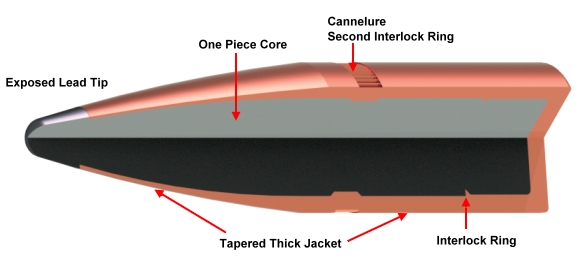
Yes, I did notice the above is not a round nose, but it is a very nice Hornady graphic, made even better with my finger pointing labeling and it does highlight the Interlock’s salient features.
 The exposed lead tip is shielded from handling and magazine storage recoil damage. Also with a tapered thickness jacket, but with heavier construction for controlled expansion and bone breaking penetration.The cannelure secures the bullet to the case, but also enhances the internal core/jacket Interlock feature.
The exposed lead tip is shielded from handling and magazine storage recoil damage. Also with a tapered thickness jacket, but with heavier construction for controlled expansion and bone breaking penetration.The cannelure secures the bullet to the case, but also enhances the internal core/jacket Interlock feature.
Unlike A frame and H frame bullet construction, the Hornady has a one piece core, encased in a jacket that tapers from thin to thick to assure proper expansion up front while maintaining an intact shank.
Personally, prior to this handloading exercise, I have had good results with the 0.338″ 250 grain version of round nose version of the Hornady Interlock in concert with the 338-378 Weatherby and 338 Remington Magnum cartridges where velocity exceeds 3000 fps. Bullets expanded, but exhibit high weight retention, where a Nosler Partition would lose its nose and retain only what was contained in the shank compartment of the jacket. So why the round nose and not the super stealth bullet form?
Now Greenhill is just a green hill…
In 1879, mathematician Alfred Greenhill developed a formula to calculate the rifling twist rate required to stabilize an elongated projectile. While there is a two level compensation for velocity, the formula is quite static, considers bullet length, but ignores many other bullet stability influences. The Greenhill formula was and is still relied upon by most firearm and component manufacturers to determine standard twist rates. Round nose, heavy for bore bullets are thickened at the ogive to shorten the overall bullet length , and theoretically allow them to stabilize in in a bore that would typically see lighter weight, spire tip bullets.
By design, both ELD-X and Interlock bullets used in this exercise stabilize with a 1:10″ twist, while the Hornady Interlock round nose heavyweight will get the job done closer as they are intended to be used. The Interlock has a slightly broader recommended muzzle velocity of 1600 – 3100 fps.
Handload notes
.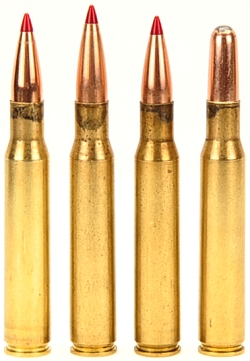
None of the loads appearing on the table below are compressed, but they are maximum charges, so the caution paragraph ahead of the handload data is for real. If you have not already done so, it is a good idea to get seater plugs offered by most reloading die manufacturers that are appropriate for VLD type bullets. With long bullet shanks and tight case neck tension, it is possible to deform bullets just behind the tip with conventional seater plug contact. Ask me how I know.
I did work through a good number of powder types recommended for these combinations. Some powder types and primer types worked well, others did not. Different lots may vary performance, but listed are the ones that worked well for me.
Handload Data
Warning: Bullet selections are specific, and loads are not valid with substitutions of different bullets of the same weight. Variations in bullet length will alter net case capacity, pressure and velocity. Primer selection is specific and primer types are not interchangeable. These are maximum loads in my firearms and may be excessive in others. All loads should be reduced by 5% as a starting point for development where cartridges have greater than 40 grains in capacity and 10% for cartridges with less than 40 grain capacity following safe handloading practices as represented in established mainstream reloading manuals. Presentation of these loads does not constitute a solicitation for their use, nor a recommendation.
| Cartridge: 30-06 Springfield (60,000 PSI MAP) |
|
| Firearm | Winchester Model 70 |
| Barrel Length | 24.0″ |
| Min – Max Case Length | 2.940″ +0.0″/-0.020″ |
| Min – Max Cartridge Overall Length | 2.940″ – 3.340″ |
| Primer | CCI 250 LRM |
| Bullet Diameter | 0.3090″ +0.000″/-0.0030″ |
| Reloading Dies | Hornady FL |
| Bullet Type | Bullet Weight Grains |
Net H2O Grains Capacity |
COL” | Powder Type | Powder Charge Grains |
Muzzle Velocity fps |
Muzzle Energy ft/lbs |
100 Yd 3 Shot Group” |
| Hornady ELD-X 3076 | 200 | 56.3 | 3.340 | Re 17 | 54.0 | 2687 | 3207 | 0.8 |
| Hornady ELD-X 3076 | 200 | 56.3 | 3.340 | Re 22 | 58.0 | 2642 | 3101 | 1.2 |
| Hornady ELD-X 3076 | 200 | 56.3 | 3.340 | Superformance | 56.5 | 2694 | 3224 | 1.1 |
| Hornady ELD-X 3077 | 212 | 56.1 | 3.400 | Re 17 | 53.0 | 2653 | 3314 | 0.7 |
| Hornady ELD-X 3077 | 212 | 56.1 | 3.400 | Re 22 | 58.0 | 2611 | 3210 | 1.1 |
| Hornady ELD-X 3077 | 212 | 56.1 | 3.400 | Superformance | 56.5 | 2684 | 3392 | 0.9 |
| Hornady ELD-X 3078 | 220 | 53.6 | 3.340 | Re 23 | 57.0 | 2553 | 3185 | 0.9 |
| Hornady ELD-X 3078 | 220 | 53.6 | 3.340 | Superformance | 56.0 | 2617 | 3346 | 0.7 |
| Hornady ELD-X 3078 | 220 | 53.6 | 3.340 | IMR 7828 SSC | 57.5 | 2582 | 3258 | 1.0 |
| Hornady Interlock 3090 | 220 | 57.5 | 3.210 | Re 23 | 57.0 | 2541 | 3155 | 1.2 |
| Hornady Interlock 3090 | 220 | 57.5 | 3.210 | Superformance | 55.5 | 2579 | 3250 | 1.1 |
| Hornady Interlock 3090 | 220 | 57.5 | 3.210 | IMR 7828 SSC | 58.0 | 2566 | 3217 | 1.2 |
The 30-06 Springfield with Hornady bullets was a straight forward handloading effort. No special prep, no special handling. It is, however, good to see that even an old timer cartridge can get a new lease on life with modern bullet and powder technology.I’ve had good results with Superformance powder where data is available, or where I have had the time to work up handloads. I wish Hornady would publish more.
Ten years ago my bullet stock was mostly Sierra and Nosler, but these days both companies lack in component product support. Published Sierra data is so old, many of the recent cartridge developments are missing and their recent VLD type bullets are priced up to 30% higher than competing brands. Nosler seems to have not updated their information to include many of the more recent powders and their bullet prices are unsupportable. Their solution to non-competitive pricing is to put 50 rather than 100 bullets in a box and leave the price per box the same.
I’m glad Hornady has stayed in handloading, components and equipment. I guess they understand that if you want to have a market to sell into, cultivating products peripheral to guns and ammo is essential to building an interest in shooting sports.
And back to the Winchester Super Grade

The high, straight comb, quality recoil pad and little bit of heft combined to effectively dampen recoil, even with the stiff heavy bullet loads. The barrel never got more than reasonably warm and the feed and cycling was always slick. In a world of synthetic stocks and modest metal finishes, the Winchester Super Grade is a standout. Teamed up with the 30-06 Springfield, it is a classic combination. Nice rifle, fun project.

Email Notification